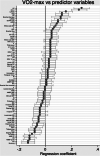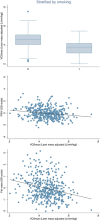Detailed investigation of multiple resting cardiovascular parameters in relation to physical fitness
- PMID: 36408896
- PMCID: PMC10108008
- DOI: 10.1111/cpf.12800
Detailed investigation of multiple resting cardiovascular parameters in relation to physical fitness
Abstract
Objective: Maximal oxygen consumption at an exercise test (VO2 -max) is a commonly used marker of physical fitness. In the present study, we aimed to find independent clinical predictors of VO2 -max by use of multiple measurements of cardiac, respiratory and vascular variables collected while resting.
Methods: In the Prospective study of Obesity, Energy and Metabolism (POEM), 420 subjects aged 50 years were investigated regarding endothelial function, arterial compliance, heart rate variability, arterial blood flow and atherosclerosis, left ventricular structure and function, lung function, multiple blood pressure measurements, lifestyle habits, body composition and in addition a maximal bicycle exercise test with gas exchange (VO2 and VCO2 ).
Results: When VO2 -max (indexed for lean mass) was used as the dependent variable and the 84 hemodynamic or metabolic variables were used as independent variables in separate sex-adjusted models, 15 variables showed associations with p < 0.00064 (Bonferroni-adjusted). Eight independent variables explained 21% of the variance in VO2 -max. Current smoking and pulse wave velocity (PWV) were the two major determinants of VO2 -max (explaining each 7% and 3% of the variance; p < 0.0001 and p = 0.008, respectively). They were in order followed by vital capacity, fat mass, pulse pressure, and high-density lipoprotein (HDL)-cholesterol. The relationships were inverse for all these variables, except for vital capacity and HDL.
Conclusion: Several metabolic, cardiac, respiratory and vascular variables measured at rest explained together with smoking 21% of the variation in VO2 -max in middle-aged individuals. Of those variables, smoking and PWV were the most important.
Keywords: VO2-max; exercise test; physical fitness; pulse wave velocity; smoking.
© 2022 The Authors. Clinical Physiology and Functional Imaging published by John Wiley & Sons Ltd on behalf of Scandinavian Society of Clinical Physiology and Nuclear Medicine.
Conflict of interest statement
The authors declare no conflict of interest.
Figures


Similar articles
-
Impaired glucose control is associated with multiple cardiovascular impairments.Clin Physiol Funct Imaging. 2020 Jul;40(4):257-268. doi: 10.1111/cpf.12634. Epub 2020 May 5. Clin Physiol Funct Imaging. 2020. PMID: 32298517
-
Ergometric performance and cardiovascular profile of obesity clinic patients.Bull Soc Sci Med Grand Duche Luxemb. 2014;(3):7-24. Bull Soc Sci Med Grand Duche Luxemb. 2014. PMID: 25571669
-
Influence of excess adiposity on exercise fitness and performance in overweight children and adolescents.Pediatrics. 2005 Jun;115(6):e690-6. doi: 10.1542/peds.2004-1543. Pediatrics. 2005. PMID: 15930197 Free PMC article.
-
Physical fitness, physical activity, and cardiovascular disease risk factors in adolescents: the Oslo Youth Study.Prev Med. 1988 Jan;17(1):12-24. doi: 10.1016/0091-7435(88)90068-0. Prev Med. 1988. PMID: 3362798
-
Genomic and transcriptomic predictors of response levels to endurance exercise training.J Physiol. 2017 May 1;595(9):2931-2939. doi: 10.1113/JP272559. Epub 2016 Jul 3. J Physiol. 2017. PMID: 27234805 Free PMC article. Review.
References
-
- Amara, C.E. , Koval, J.J. , Johnson, P.J. , Paterson, D.H. , Winter, E.M. & Cunningham, D.A. (2000) Modelling the influence of fat‐free mass and physical activity on the decline in maximal oxygen uptake with age in older humans. Experimental Physiology, 85, 877–885. - PubMed
-
- Augustine, J.A. , Yoon, E.S. , Choo, J. , Heffernan, K.S. & Jae, S.Y. (2016) The relationship between cardiorespiratory fitness and aortic stiffness in women with central obesity. Journal of Women's Health, 25, 680–686. - PubMed
-
- Bernaards, C.M. , Twisk, J.W.R. , Van Mechelen, W. , Snel, J. & Kemper, H.C.G. (2003) A longitudinal study on smoking in relationship to fitness and heart rate response. Medicine and Science in Sports and Exercise, 35, 793–800. - PubMed
-
- Binder, J. , Bailey, K. , Seward, J. , Squires, R. , Kunihiro, T. , Hensrud, D. et al. (2006) Aortic augmentation index is inversely associated with cardiorespiratory fitness in men without known coronary heart disease. American Journal of Hypertension, 19, 1019–1024. - PubMed

